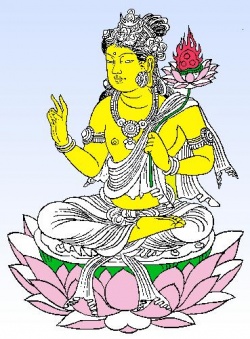Difference between revisions of "Sarvanivarana-Vishkambhin"
| (10 intermediate revisions by 3 users not shown) | |||
| Line 1: | Line 1: | ||
| − | [[Sarvanivāraṇaviṣkambhin|Sarvanivāraṇaviṣkambhin]] (Chinese: Chú Gàizhàng pPsà 除蓋障菩薩; or Jìngzhū Yèzhàng Púsà 凈諸業障菩薩; Tibetan: Dripa Namsal) is a [[Bodhisattva|bodhisattva]] revered in [[Mahāyāna|Mahāyāna]] Buddhism. He is one of the Eight Great Bodhisattvas with [[Mañjuśrī]], [[Samantabhadra|Samantabhadra]], [[Avalokiteśvara|Avalokiteśvara]], [[Mahāsthāmaprāpta|Mahāsthāmaprāpta]], Âkāśagarbha ([[Akasagarbha|Akasagarbha]]), Kṣitigarbha and [[Maitreya|Maitreya]]. | + | [[File:Image136.jpg|thumb|250px|]] |
| + | [[Sarvanivāraṇaviṣkambhin|Sarvanivāraṇaviṣkambhin]] ({{Wiki|Chinese}}: [[Chú Gàizhàng pPsà]] [[除蓋障菩薩]]; or [[Jìngzhū Yèzhàng Púsà]] [[凈諸業障菩薩]]; [[Tibetan]]: [[Dripa Namsal]]) is a [[Bodhisattva|bodhisattva]] revered in [[Mahāyāna|Mahāyāna]] [[Buddhism]]. He is one of the Eight [[Great]] [[Bodhisattvas]] with [[Mañjuśrī]], [[Samantabhadra|Samantabhadra]], [[Avalokiteśvara|Avalokiteśvara]], [[Mahāsthāmaprāpta|Mahāsthāmaprāpta]], [[Âkāśagarbha]] ([[Akasagarbha|Akasagarbha]]), [[Kṣitigarbha]] and [[Maitreya|Maitreya]]. | ||
== Role == | == Role == | ||
| − | He is invoked to remove or eliminate all the obstacles to insure a successful meditation. | + | He is invoked to remove or eliminate all the {{Wiki|obstacles}} to insure a successful [[meditation]]. |
== Nivāraṇa == | == Nivāraṇa == | ||
| − | Although the eight Mahāsattvas belong to the current [[Mahāyāna|Mahāyāna]], the term nivāraṇa is most commonly used in the [[Theravada|Theravada]] texts where it refers to the five mental obstacles: desire (kamacchanda), hostility (vyapada), | + | Although the eight [[Mahāsattvas]] belong to the current [[Mahāyāna|Mahāyāna]], the term nivāraṇa is most commonly used in the [[Theravada|Theravada]] texts where it refers to the five [[mental]] {{Wiki|obstacles}}: [[desire]] ([[kamacchanda]]), [[hostility]] ([[vyapada]]), [[Laziness]] ([[thinamiddha]]), {{Wiki|distraction}} and {{Wiki|worry}} (uddhachcha-kukuchcha), [[doubts]] (vichikicha) towards the [[Three Jewels]]. Sarvanivāraṇaviṣkambhi is best known to [[meditators]] and is not an important [[subject]] to {{Wiki|individual}} {{Wiki|worship}} like the other seven [[mahāsattvas]]. |
| − | == In Vajrayāna == | + | == In [[Vajrayāna]] == |
| − | In Tantric Buddhism, he is usually placed in the lineage of [[Amoghasiddhi|Amoghasiddhi]] Buddha, one of the [[Five_Dhyani_Buddhas|five Dhyani Buddhas]], more rarely of Akshobhya Buddha. He is sometimes considered a form of Vajrapāṇi, this is most likely a confusion with the [[Mahāsattva|mahāsattva]] Mahāsthāmāprāpta which Vajrapāṇi is one of its incarnations. | + | In [[Tantric Buddhism]], he is usually placed in the [[lineage]] of [[Amoghasiddhi|Amoghasiddhi]] [[Buddha]], one of the [[Five_Dhyani_Buddhas|five Dhyani Buddhas]], more rarely of [[Akshobhya]] [[Buddha]]. He is sometimes considered a [[form]] of [[Vajrapāṇi]], this is most likely a [[confusion]] with the [[Mahāsattva|mahāsattva]] Mahāsthāmāprāpta which [[Vajrapāṇi]] is one of its [[incarnations]]. |
| − | == Iconography == | + | == {{Wiki|Iconography}} == |
| − | In iconography, he has often a flower in one hand, sometimes with a jewel (Cintamaṇi). | + | In {{Wiki|iconography}}, he has often a [[flower]] in one hand, sometimes with a [[jewel]] (Cintamaṇi). |
| − | == Sutras concerned == | + | == [[Sutras]] concerned == |
| − | He is mentioned in the Lotus Sutra, in which he will pay homage to [[Avalokiteśvara|Avalokiteśvara]] in Varanasi, and in the Mahavairocana Tantra. | + | He is mentioned in the [[Lotus Sutra]], in which he will pay homage to [[Avalokiteśvara|Avalokiteśvara]] in [[Varanasi]], and in the [[Mahavairocana]] [[Tantra]]. |
| − | == Mantra == | + | == [[Mantra]] == |
| − | The mantra of this great [[Bodhisattva|bodhisattva]] to remove all obstacles and disturbances mentioned in the Vairocanasūtra, is as follows: Namaḥ samantabuddhānāṃ! Aḥ! Sattva Hitābhyudgata,Traṃ! Traṃ! Raṃ! Raṃ! | + | The [[mantra]] of this great [[Bodhisattva|bodhisattva]] to remove all {{Wiki|obstacles}} and {{Wiki|disturbances}} mentioned in the Vairocanasūtra, is as follows: [[Namaḥ]] samantabuddhānāṃ! Aḥ! [[Sattva]] Hitābhyudgata,Traṃ! Traṃ! Raṃ! Raṃ! [[Svāhā]]! |
{{W}} | {{W}} | ||
[[Category:Chinese Buddhism]] | [[Category:Chinese Buddhism]] | ||
| − | [[Category: | + | |
| − | [[Category: | + | |
| + | [[Category:Buddhist Terms]] | ||
| + | [[Category:Sarvanivarana-Vishkambhin]] | ||
Latest revision as of 06:22, 1 January 2015
Sarvanivāraṇaviṣkambhin (Chinese: Chú Gàizhàng pPsà 除蓋障菩薩; or Jìngzhū Yèzhàng Púsà 凈諸業障菩薩; Tibetan: Dripa Namsal) is a bodhisattva revered in Mahāyāna Buddhism. He is one of the Eight Great Bodhisattvas with Mañjuśrī, Samantabhadra, Avalokiteśvara, Mahāsthāmaprāpta, Âkāśagarbha (Akasagarbha), Kṣitigarbha and Maitreya.
Role
He is invoked to remove or eliminate all the obstacles to insure a successful meditation.
Nivāraṇa
Although the eight Mahāsattvas belong to the current Mahāyāna, the term nivāraṇa is most commonly used in the Theravada texts where it refers to the five mental obstacles: desire (kamacchanda), hostility (vyapada), Laziness (thinamiddha), distraction and worry (uddhachcha-kukuchcha), doubts (vichikicha) towards the Three Jewels. Sarvanivāraṇaviṣkambhi is best known to meditators and is not an important subject to individual worship like the other seven mahāsattvas.
In Vajrayāna
In Tantric Buddhism, he is usually placed in the lineage of Amoghasiddhi Buddha, one of the five Dhyani Buddhas, more rarely of Akshobhya Buddha. He is sometimes considered a form of Vajrapāṇi, this is most likely a confusion with the mahāsattva Mahāsthāmāprāpta which Vajrapāṇi is one of its incarnations.
Iconography
In iconography, he has often a flower in one hand, sometimes with a jewel (Cintamaṇi).
Sutras concerned
He is mentioned in the Lotus Sutra, in which he will pay homage to Avalokiteśvara in Varanasi, and in the Mahavairocana Tantra.
Mantra
The mantra of this great bodhisattva to remove all obstacles and disturbances mentioned in the Vairocanasūtra, is as follows: Namaḥ samantabuddhānāṃ! Aḥ! Sattva Hitābhyudgata,Traṃ! Traṃ! Raṃ! Raṃ! Svāhā!
